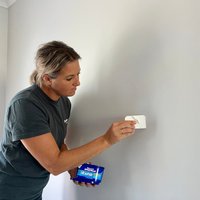- Subscribe to RSS Feed
- Mark as New
- Mark as Read
- Bookmark
- Subscribe
- Printer Friendly Page
- Report Inappropriate Content
Difficulty: Beginner
Turn a blank slate into a beautiful brick feature wall using just paint.
This simple and low-cost painting project creates a feature that is bound to impress and adds character to your room.
Video Tutorial
Steps
Step 1
1/9Prepare your wall for painting.
Lay down a drop sheet or some old towels to protect your flooring.
Brick feature walls are great for hiding small imperfections in your wall. However, it is a good idea to patch any large holes in the wall before painting. Once fully dry, sand the filler and wash the wall using sugar soap before starting painting.

Step 2
2/9Create guidelines for your bricks.
Using a level and a pencil, draw straight lines scattered across the entire wall. These lines will later be used as a guide when painting to help keep the bricks straight.

Step 3
3/9Prepare your sponge.
Grab a new, unused sponge and cut it to size, roughly 15cm x 7cm. Use an absorbent sponge with plenty of holes and texture on the flat side. A smooth sponge will not create that brick-look texture on the wall.
Keep the offcuts of the sponge, as you will need them later.

Step 4
4/9Apply paint to the sponge.
Grab an old container or tray large enough to fit the sponge. Pour your base colour paint into the container, adding just enough to cover the bottom. I used light brown as my base.
Place the sponge into the container face down to soak up the paint. Once the bottom side is covered in paint, remove the sponge and scrape off any excess paint onto the side of the container.


Step 5
5/9Add brick textures to the wall.
Starting at the top corner of the wall, carefully press the wet paint side of the sponge onto the wall. Use your fingers to press around the sponge to ensure its entire surface touches the wall.
Remove the sponge off the wall and repeat next to it to create more bricks, working your way across and down.
With each new row, offset the sponge by half a brick to replicate a brick pattern. Use the pencil lines on the wall as a guide to keep them straight.
Note: it is not necessary to add more paint to the sponge for each brick. However, as the sponge runs lower on paint, the bricks will appear lighter. It’s a good idea to spread out your bricks (working both across and down instead of just straight across) to prevent clusters of darker and lighter bricks.
If you cannot fit a full brick at the edge of the wall, leave it blank for now. You will cut down the sponge to fill the gaps with a smaller brick in the next step.


Step 6
6/9Fill the gaps.
Once you have completed all the full-sized bricks on your wall, cut your sponge in half and use it to fill in the half-size gaps along the edges in every second row.
If you are left with odd-sized gaps along the bottom of the wall, cut a sponge into smaller strips to suit and follow the same method as in step 5 to print the bricks. Use a small paintbrush to touch up any small gaps.




Step 7
7/9Vary the brick colour.
Pour a small amount of your next paint colour into a clean container. A darker shade of your original base colour is a great choice for this step. I used a darker brown.
Cut a small piece of sponge from your offcut piece, at least 3 x 3cm.
Dip the sponge into the paint and gently dab it onto small sections of just some of the previously painted bricks. This method creates contrast and shadowing, which adds further character to the overall look.



Step 8
8/9Add more colours.
Pour your next paint colour into a clean container. I used a mustard colour for this next step.
Cut another piece of your sponge and repeat the method in step 7.
When using multiple bold colours, use sparingly. Paint just a few scattered bricks, then stop and assess until you achieve your desired look.
Repeat this step for each of your chosen colours. I used two more colours: a reddish brown and a black/brown, both used sparingly.





Step 9
9/9Remove pencil guideline marks.
Once the paint has dried, use an eraser to remove any visible pencil lines from the wall.
You have now completed your brick feature wall.


Materials
Tools
- Filler (if needed)
- Sugar soap (if needed)
- Sample paint pots in a few different colours. (I used a light brown as my base, plus a darker shade of brown, a mustard colour, a reddish brown and a black/brown for contrast, shadowing and character.)
- Scissors
- Small paint brush
- Level
- Pencil
- Eraser
- Old container
- Sponge
- Drop sheet.
Images






























You must be a registered Workshop community member to comment. Please join Workshop or sign in to join in the discussion.
Why join the Bunnings Workshop community?
Workshop is a friendly place to learn, get ideas and find inspiration for your home improvement projects
| Subject | Author | Posted | |
|---|---|---|---|
| July 2021 | |||
| December | |||
| August 2023 | |||
| October | |||
| August |

















